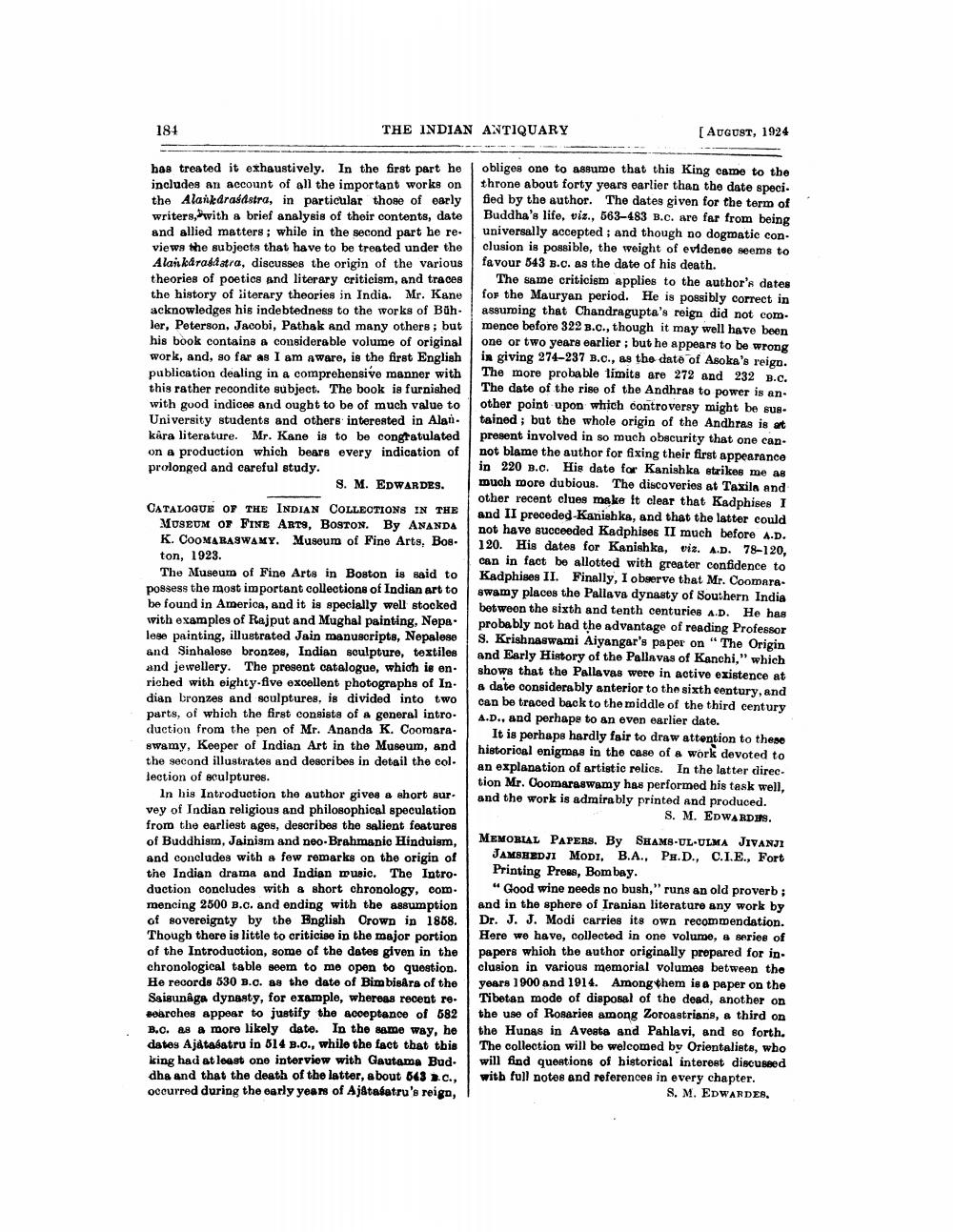________________
18+
THE INDIAN ANTIQUARY
[ AUGUST, 1924
bas treated it exhaustively. In the first part he obliges one to assume that this King came to the includes an account of all the important works on throne about forty years earlier than the date speci. the Alankdrasastra, in particular those of early
fied by the author. The dates given for the term of writers, with a brief analysis of their contents, date Buddha's life, viz., 563-483 B.C. are far from being and allied matters; while in the second part be re. universally accepted ; and though no dogmatic con. views the subjects that have to be treated under the clusion is possible, the weight of evidence seems to Alaikärasiatra, discusses the origin of the various favour 543 B.C. as the date of his death. theories of poetics and literary criticism, and traces The same criticism applies to the author's detes the history of literary theories in India. Mr. Kane for the Mauryan period. He is possibly correct in acknowledges his indebtedness to the works of Büh. assuming that Chandragupta's reign did not com. Jer, Peterson, Jacobi, Pathak and many others; but mence before 322 B.c., though it may well have been his book contains a considerable volume of original one or two years earlier ; but he appears to be wrong work, and, so far as I am aware, is the first English in giving 274-237 B.C., as the date of Asoka's reign. publication dealing in a comprehensive manner with The more probable limits are 272 and 232 B.C. this rather recondite subject. The book is furnished The date of the rise of the Andhras to power is anwith good indices and ought to be of much value to other point upon which controversy might be susUniversity students and others interested in Alan. tained; but the whole origin of the Andhras is at kara literature. Mr. Kane is to be congratulated present involved in so much obscurity that one can. on a production which bears every indication of not blame the author for fixing their first appearance prolonged and careful study.
in 220 B.C. His date for Kanishka strikes me as S. M. EDWARDES.
much more dubious. The discoveries at Taxila and
other recent clues make it clear that Kadphises I CATALOGUE OF THE INDIAN COLLECTIONS IN THE
and II preceded Kanishka, and that the latter could MUSEUM OF FINE ARTS, BOSTON. BY ANANDA
not have succeeded Kadphises II much before A.D. K. COOMARASWAMY. Museum of Fine Arts, Bos. 120. His dates for Kanishka, viz.A.D. 78-120, ton, 1923.
can in fact be allotted with greater confidence to The Museum of Fine Arts in Boston is said to Kadphises II. Finally, I observe that Mr. Coomarapossess the most important collections of Indian art to swamy places the Pallava dynasty of Southern India be found in America, and it is specially well stocked betweon the sixth and tenth centuries A.D. He has with examples of Rajput and Mughal painting, Nope. probably not had the advantage of reading Professor lese painting, illustrated Jain manuscripts, Nepalese S. Krishnaswami Aiyangar's paper on "The Origin and Sinhalese bronzes, Indian sculpture, textiles and Early History of the Pallavas of Kanchi," which and jewellery. The present catalogue, which is en shows that the Pallaves were in active existence at riched with eighty-five excellent photographs of In. la date considerably anterior to the sixth eentury, and dian bronzes and sculptures, is divided into two can be traced back to the middle of the third century parts, of which the first consists of a general intro.
A.D., and perhape to an even earlier date. duction from the pen of Mr. Ananda K. Coomara. It is perhaps hardly fair to draw attention to these swamy, Keeper of Indian Art in the Museum, and
historical enigmas in the case of a work devoted to the second illustrates and describes in detail the col.
an explanation of artistic relics. In the latter direc. lection of sculptures.
tion Mr. Ooomaraswamy has performed his task well, In his Introduction the author gives a short sur. and the work is admirably printed and produced. vey of Indian religious and philosophical speculation
S. M. EDWARDS. from the earliest ages, describes the salient features of Buddhism, Jainism and neo-Brahmanio Hinduism, MEMORIAL PAPERS. BY SHAMS-UL-ULMA JIVANJI and concludes with a few remarks on the origin of JAMSHEDJI MODI, B.A., PH.D., C.I.E., Fort the Indian drama and Indian music. The Intro
Printing Press, Bombay. duction concludes with a short chronology, com. Good wine needs no bush," runs an old proverb: mencing 2500 D.C. and ending with the assumption and in the sphere of Iranian literature any work by of sovereignty by the English Orown in 1868. Dr. J. J. Modi carries its own recommendation. Though there is little to criticise in the major portion Here we have, collected in one volume, a series of of the Introduction, some of the dates given in the papers which the author originally prepared for inchronological table seem to me open to question. clusion in various memorial volumes between the He records 530 .0, as the date of Bimbisars of the years 1900 and 1914. Among them is a paper on the Saisunânga dynasty, for example, whereas recent re. Tibetan mode of disposal of the dead, another on searches appear to justify the acceptance of 582 the use of Rosaries among Zoroastrians, a third on B.O. as a more likely date. In the same way, he the Hunas in Avesta and Pahlavi, and so forth. datos Ajátaáatru in 814 B.O., while the fact that this The collection will be welcomed by Orientalists, who king had at least one interview with Gautama Bud- will find questions of historical interest discuseed dha and that the death of the latter, about 543 2.C., with full notes and references in every chapter. occurred during the early years of Ajátajatru's reign,
S. M. EDWARDES.




